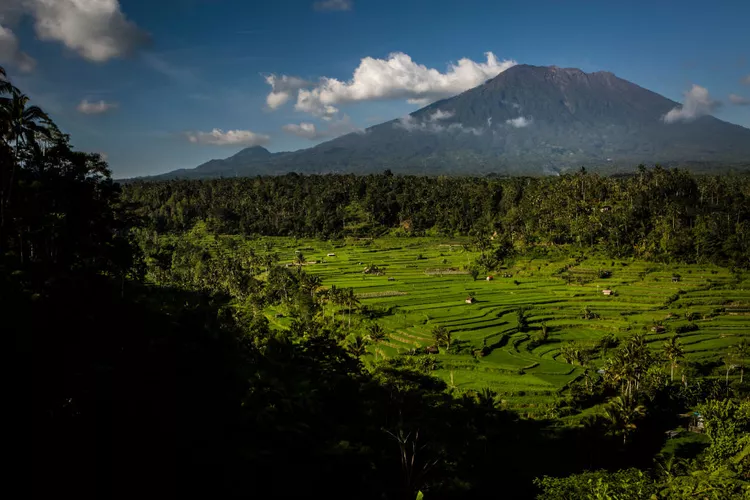1. Introduction to East Bali
There’s plenty to do and see in East Bali, as long as “party” is not at the top of the agenda. The attractions in Klungkung and Karangasem lean more toward cultural and nature-friendly pursuits.
2. Key Attractions in East Bali
The region is home to several temples and royal structures along the coast, including the most important Balinese temple of all, Pura Besakih. Hiking trails criss-cross the mountainous terrain, and the waters surrounding East Bali are full of scenic diving sites. The next time you’re in East Bali, check out one—or all—of these destinations.
3. Gunung Agung

The 10,308-foot-high Gunung Agung is Bali’s highest mountain. This active volcano’s beauty is outweighed by its potential for destruction. In March of 1963, it erupted, covering the entire island in ash and devastating villages and temples. Gunung Agung rests today, and the temples and towns in its shadow are tranquil.
Two hiking trails to the summit are popular with visitors and are best climbed between July and September. Hikers must refrain from climbing during religious ceremonies at Pura Besakih, ensuring respect for the sacred grounds.
4. Pura Besakih: The Mother Temple

Pura Besakih, known as the “Mother Temple,” is the largest temple in Bali—a sprawling complex of over 20 temples set on the side of Gunung Agung. This temple complex honors the Hindu trinity (trimurti) of Brahma, Vishnu, and Shiva, attracting thousands of pilgrims and tourists each year.
With over 50 festivals celebrated at Pura Besakih annually, visitors are likely to witness at least one celebration during their stay. It’s advisable to check with your local accommodations for festival schedules. The temple is most easily accessed via a bemo from Klungkung.
5. USAT Liberty Wreck, Tulamben

The USAT Liberty was an American merchant ship torpedoed by Japanese forces during World War II. After taking on water, the ship was beached off Tulamben and later ripped in half by the 1963 eruption of Gunung Agung, sinking deeper into the water.
Today, the ruins can be explored by snorkelers and divers. The abundance of coral and marine life surrounding the ship makes the Liberty one of Bali’s most popular dive sites.
6. Puri Agung Karangasem

This 19th-century royal palace showcases a blend of Balinese, Chinese, and European influences within a complex that once housed the King of Karangasem’s court, retaining significant ceremonial importance today.
The inner court features the king’s former residence, offering glimpses into royal life through relics and photographs from the past.
7. Tirta Gangga

The last king of Karangasem constructed this bathing palace in 1948, which continues to captivate visitors. The site features a network of pools and unique architectural styles.
This current location is a reconstruction after the original structures were destroyed during the 1963 Gunung Agung eruption, but it captures the former charm with an 11-tiered fountain pagoda being the highlight. Swimming is permitted for a nominal fee.
8. Goa Lawah (Bat Cave)

Goa Lawah is an ancient temple located in front of a bat cave. The cave’s bats are primarily the attraction, as they are revered by worshippers who offer gifts nearby. Legend holds that the cave extends over 19 miles underground, reaching Pura Besakih.
Balinese Hindus consider Goa Lawah significant for afterlife practices. Worshippers participate in the Nyegara Gunung ceremony here, making offerings to purify newly released spirits before they return to their family’s household shrine.
9. Traditional Village of Tenganan

Tenganan is a notable village of the Bali Aga, the original pre-Hindu inhabitants of Bali, located about 10 minutes from Candidasa. The community adheres to a strict separation between “pure” Bali Aga and those who live outside its walls.
This village welcomes daytime tourists, presenting a distinct perspective on Balinese culture with ancient architecture, language, and ceremonies. Tenganan is renowned for its unique fabric named gringsing, believed to bestow magical powers upon its wearers.
10. Pura Luhur Lempuyang

Pura Luhur Lempuyang, despite its less popular status, is one of Bali’s most significant religious sites. As one of the island’s nine directional temples, it serves to “protect” the Balinese from evil spirits arriving from the east.
This temple presents visitors with a challenging ascent, taking around an hour and a half to reach the top. Upon arrival, a stunning view of Gunung Agung framed by the temple gate awaits.





